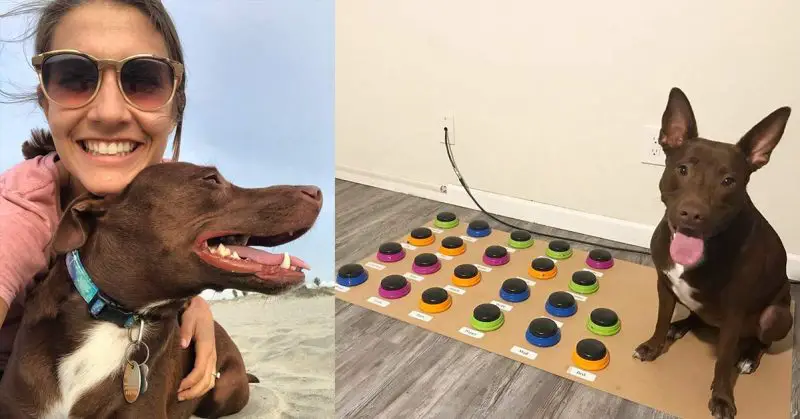While dogs can easily be trained to understand and respond to certain commands, not many people can get their dogs to express their needs and feelings. Sure, there’s the whine-talk where a dog can make different sounds such as the sad whine and confused whine, but that’s just about it.
Twenty-six-year-old Christina Hunger, a Speech-Language pathologist in California trained her dog to communicate using an Augmentative and Alternative Communication (AAC) system. [1] An AAC is a range of strategies and tools used to help people who struggle with speech. It’s usually a device with icons, tabs, or buttons, each representing a common word or emotion.
Christina works mostly with non-verbal little children, teaching them to use AACs and have the nearest thing to a freely expressive voice. She thought that since dogs are smart and can reasonably understand the human language, she might be able to train her Catahoula puppy, Stella, to use an AAC to communicate.
“At the same time as I was working predominantly with children who use AAC devices, my fiancé Jake and I got a puppy,” she wrote on her blog. [2] “Our puppy Stella quickly inspired interesting questions: If dogs can understand words we say to them, shouldn’t they be able to say words to us? Can dogs use AAC to communicate with humans?“
Apparently, they can!
Stella’s first word was ‘outside.’
Christina and her fiancé tested out their theory by using the Pavlovian Conditioning method. Every time they opened the door to let Stella outside, they pressed a sound button they’d created to say ‘outside.’ After a few weeks, every time the door was opened and Christina asked if she wanted to go outside, Stella would begin to look at the button excitedly.
“As an SLP I knew this was a huge step in the right direction,” Christina wrote. “She was demonstrating joint attention between the button and me and understood that to go outside, something with the button had to occur first. Soon after this step, Stella said her first word, ‘outside’ independently.“
While Stella was still having fun with her “outside” button, Christina introduced more buttons to the soundboard to say words like “eat,” “water,” “play,” “walk,” “no,” “come,” “help,” “bye,” and “love you.”
Christina and fiancé refrained from rewarding Stella with treats for using her words correctly. They wanted her to learn to communicate efficiently and not associate her activities with treats. Christina trained her like she would train the kids in speech therapy sessions, and with time, the pooch showed remarkable progress.
“If Jake and I were distracted, Stella began saying ‘play’ repeatedly until we threw her toy or engaged in a tug of war. Stella would walk to her water bowl, notice it was empty and say ‘water’,” Christina wrote. “If we had finished dinner and didn’t mention going for a walk yet, Stella would say ‘walk’ multiple times while staring at us.”
Stella can now make simple sentences
Christina was amazed when Stella began to make two-word phrases with her soundboard. If they took too long to feed her, she would combine the ‘eat’ and ‘no’ buttons to say ‘eat no.’ If she needed help with something in another room, she would combine the ‘help’ and ‘come’ buttons to say ‘help come.’ The dog could recognize what would happen when she pressed each button, and she was able to associate multiple events together to communicate more efficiently.
“One afternoon shortly after the Daylight Savings time change, Stella said, ‘eat’ repeatedly at about 3:00 PM,” Christina wrote. “When Jake and I did not feed her dinner this early, she said, ‘love you no’ and walked into the other room.”
Stella is currently familiar with about 29 words and can string up to five at a time to make a sentence. People online are in love with the smart dog and dozens are excited at the prospect of training their dogs to use sentences — even if not verbally. Stella and Christina now have over 424K followers on their Instagram account named Hunger 4 Words.
Christina explains that Stella’s AAC is just the beginning of her speech journey and she plans to explore other options to help the dog communicate more easily.
“I think [about] how important dogs are to their humans,” Christina says. “I just imagine how much deeper the bond will be.”
Video and photo credits: Hunger 4 Words – Instagram
Reference:
- “Speech pathologist teaches her dog to use a soundboard and now it communicates in sentences,” Upworthy. November 2008.
- “Teaching My Dog to Talk,” Hunger 4 Words. April 2019.
- “Pavlov’s Dogs and Classical Conditioning,” Psychologist World
- “Hunger 4 Words,” Instagram.

